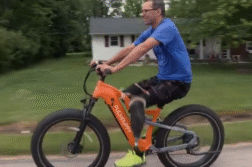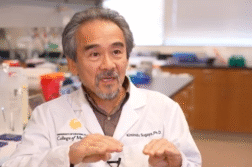GAINESVILLE, Fla. (Ivanhoe Newswire) — Not many people look forward to going to the dentist, especially children. Now, there’s a new liquid doctors are using to fight cavities painlessly, without a drill.
“They’re going to pull my teeth out,” said six-year-old Uriah Webb.
Just ask Uriah’s mom how much they both hate the dentist’s office.
“Crying, screaming, running, don’t want you to look in his mouth,” Andrea Webb told Ivanhoe.
But those nightmarish appointments may be just a bad memory. Even for someone with cavities. Thanks to a new liquid called silver diamine fluoride. It’s been used in other countries for decades, but only recently approved by the FDA for the U.S. It’s marketed as advantage arrest.
“What’s so exciting about it is, it’s the first time in modern history really that we have something that can actually arrest the decay process,” detailed, Scott L. Tomar, DMD, DrPH Professor and Chair, Department of Community Dentistry and Behavioral Science at the University of Florida College of Dentistry in Gainesville, Florida.
Dr. Tomar loves the cavity fighting liquid. He actually teaches dental students and dentists how to use it.
Dr. Tomar explained, “You dab a small amount onto the cavity with a tiny brush, dab it on there for about two minutes, rinse it off, air dry it.”
Here’s how it works. Dr. Tomar said the liquid desensitizes the tooth. The anti-microbial properties also stop cavities from getting worse and it even prevents them. Too good to be true? There is a downside. It can darken and even blacken teeth. Despite the risks, this mom says it’s much better than traumatizing kids to the point they want to avoid dentists altogether.
Andrea said, “I see other kid’s teeth that are my kid’s age and they have no teeth. They are rotten down. They’re gone. It’s just horrible.”
It’s not mandatory for dentists to use silver diamine fluoride, but Dr. Tomar said parents should talk it over with their dentist.
Silver diamine fluoride is already used in hundreds of dental offices. At least 18 dental schools have started teaching the next generation of pediatric dentists how to use it. The cost generally is much lower than a filling, probably about one-fourth of the cost in most cases. It takes less chair time, fewer supplies and materials.
Contributors to this news report include: Sarah Rosario, Producer; Roque Correa, Editor; Dan & Deb Huntting, Videographer.
Free weekly e-mail on Medical Breakthroughs from Ivanhoe. To sign up: http://www.ivanhoe.com/ftk
FIGHTING CAVITIES WITHOUT A DENTIST DRILL
REPORT #2464
BACKGROUND: Tooth decay damages the tooth creating holes called cavities. It can affect the enamel (the outer coating of a tooth) and the dentin (the inner layer). A common misconception is that a cavity is caused only by sugar, which is simply not true; cavities are also caused by carbohydrates like bread, cereal, milk, soda, or fruit. When the carbohydrates nest in the mouth, the bacteria in the mouth turn them into acids. The culmination of bacteria acid, food debris, and salvia forms a plaque which clings to the teeth. A cavity is then formed when the acids in plaque dissolve the enamel. Children and adults alike suffer from cavities which can significantly diminish the quality of life. However, adults get cavities due to changes in the mouth such as the gum pulling away from the tooth. Decay sometimes occurs around the edges of fillings for seniors. Seniors are often subjected to a lot of dental problems because of lack of fluoride or good oral care when they were children. As the years progress, these fillings can weaken teeth and break, bacteria gather in the space and cause decay.
(Source: http://www.webmd.com/oral-health/guide/dental-health-cavities#1)
THE TREATMENT: Dentists remove cavities with the help of a drill that extracts the decayed portion of the tooth. Afterwards, they fill the hole with a filling made of either silver alloy, gold, porcelin, or a composite resin. Another kind of treatment is called Silver Diamine Fluoride (SDF). Dr. Tomar says “SDF can be used on primary (baby) teeth or permanent teeth. It is most commonly used on baby teeth because it is a non-invasive way to manage cavities in young children without drilling and sedation or general anesthesia, and can stabilize the situation until the child is old enough to be treated without sedation or until the tooth naturally falls out. On the other end of the age spectrum, SDF is being used on older adults to conservatively manage decay that is difficult to treat, such as decay or root surfaces and in patients who cannot easily be transported for dental care. The discoloration is likely permanent, but in many cases, it is possible to cover the darkened area with a tooth-colored filling, often without needles or drilling.”
(Source: Scott L. Tomar, DMD, DrPH and http://www.webmd.com/oral-health/guide/dental-health-cavities#1)
GUM DISEASE: Plaque causes gum disease; it is an infection in the tissues that surround and support our teeth. Gum disease is the largest cause of tooth loss in adults. It is often painless, but there are a couple of symptoms that may signal a problem: red and tender gums that bleed easily, persistent bad breath or bad taste, permanent teeth that are loose or separating. Also, changes in the way the teeth join together when you bite or the way the partial dentures fit. Poor oral hygiene, smoking or chewing tobacco, genetics, crooked teeth that are hard to keep clean, pregnancy, diabetes, and some medications can increase the risk of developing gum disease. The early stage of gum disease is gingivitis; it is reversible and can usually be eliminated by a professional cleaning at a dental office, coupled with daily brushing and flossing. The disease has progressed to the advanced stage, periodontitis, when the teeth start to feel loose and start moving around the mouth.
(Source: http://www.mouthhealthy.org/en/az-topics/g/gum-disease)
* For More Information, Contact:
Scott L. Tomar, DMD, MPH, DrPH Rossana Passaniti, UF Media Relations Mgr.
Professor & Chair passer@shands.ufl.edu
Dept. of Community Dentistry & Behavioral Science 352-273-8569
University of Florida College of Dentistry



